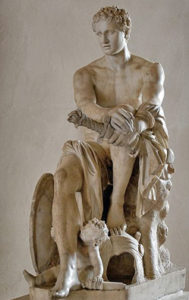GREEK (G)
- HERA
- HESTIA
- ATHENA
- DEMETER
- ARTEMIS
- APHRODITE
- ARES
- HERMES
- ZEUS
- POSEIDON
- HEPHAESTUS
- APOLLO
- HELIOS
- NIKE
- DIONYSUS
ROMAN (R)
- JUNO
- VESTA
- MINERVA
- CERES
- DIANA
- VENUS
- MARS
- MERCURY
- JUPITER
- NEPTUNE
- VULCAN
- APOLLO
- SOL
- VICTORIUS
- BACCHUS
ASSOCIATION
- MATRON
- HEARTH
- WISDOM / WAR
- EARTH / HARVEST
- HUNT
- LOVE
- WAR
- TRADE
- SKY / RULE
- SEA
- FIRE / SMITH
- LIGHT / ARTS
- SUN
- VICTORY
- WINE
GREEK DEITIES
ATHENA
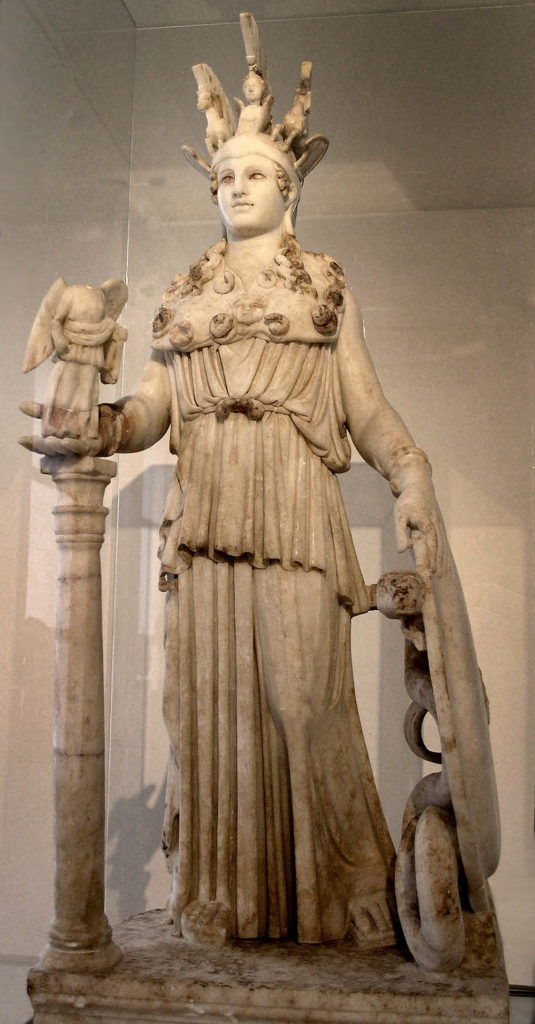 One of the most important goddesses. Athena sprang full grown and armored from the forehead of the god Zeus and was his favorite child. He entrusted her with his shield. She was the primarily the goddess of the Greek cities, of industry and the arts, wisdom and war. Athena was a patron of the agricultural arts and of the crafts of women, especially spinning and weaving. Among her gifts to man were the inventions of the plow and the flute and the art of taming animals, building ships, and making shoes. She was often associated with birds, especially the owl.
One of the most important goddesses. Athena sprang full grown and armored from the forehead of the god Zeus and was his favorite child. He entrusted her with his shield. She was the primarily the goddess of the Greek cities, of industry and the arts, wisdom and war. Athena was a patron of the agricultural arts and of the crafts of women, especially spinning and weaving. Among her gifts to man were the inventions of the plow and the flute and the art of taming animals, building ships, and making shoes. She was often associated with birds, especially the owl.
ARTEMIS
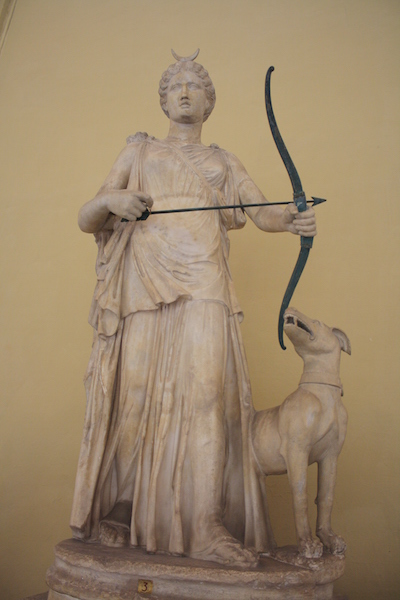 One of the principal goddesses. Daughter of Zeus and the twin sister of the god Apollo. She was the chief hunter to the gods and goddess of hunting and of wild animals, especially bears. She was also the goddess of childbirth. Like Apollo, Artemis was armed with a bow and arrows.
One of the principal goddesses. Daughter of Zeus and the twin sister of the god Apollo. She was the chief hunter to the gods and goddess of hunting and of wild animals, especially bears. She was also the goddess of childbirth. Like Apollo, Artemis was armed with a bow and arrows.
APHRODITE
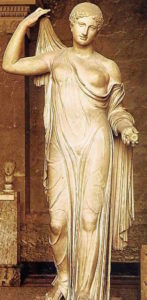 The goddess of love and beauty. In theology she is described as having sprung from the foam of the sea and her name may mean “foam-risen”.
The goddess of love and beauty. In theology she is described as having sprung from the foam of the sea and her name may mean “foam-risen”.
HERMES
 Messenger of the gods, the son of Zeus. Hermes was the special servant and courier of Zeus, he had winged sandals and a winged hat and bore a golden Caduceus, or magic wand. He conducted the souls of the dead to the underworld and was believed to possess magical powers over sleep and dreams. He was also the deity of athletes, protected gymnasiums and stadiums and was believed to be responsible for both good luck and wealth. His presentation of the lyre to Apollo was the reconciliation of brothers from Hermes theft of Apollo’s cattle. In art as a mature bearded man, in classical art he is an athletic youth, nude and beardless.
Messenger of the gods, the son of Zeus. Hermes was the special servant and courier of Zeus, he had winged sandals and a winged hat and bore a golden Caduceus, or magic wand. He conducted the souls of the dead to the underworld and was believed to possess magical powers over sleep and dreams. He was also the deity of athletes, protected gymnasiums and stadiums and was believed to be responsible for both good luck and wealth. His presentation of the lyre to Apollo was the reconciliation of brothers from Hermes theft of Apollo’s cattle. In art as a mature bearded man, in classical art he is an athletic youth, nude and beardless.
ZEUS
 The god of the sky and ruler of the Olympian gods. Zeus was considered the father of the gods and of mortals. He did not create either gods or mortals; he was their father in the sense of being the protector and ruler both of the Olympian family and the human race. He was lord of the sky, the rain god, and the cloud gatherer, who wielded the terrible thunderbolt. His breastplate was the aegis, his bird the eagle, his tree the oak. Zeus is pictured in two very different ways. He is represented as the god of justice and mercy, the protector of the weak, and the punisher of the wicked.
The god of the sky and ruler of the Olympian gods. Zeus was considered the father of the gods and of mortals. He did not create either gods or mortals; he was their father in the sense of being the protector and ruler both of the Olympian family and the human race. He was lord of the sky, the rain god, and the cloud gatherer, who wielded the terrible thunderbolt. His breastplate was the aegis, his bird the eagle, his tree the oak. Zeus is pictured in two very different ways. He is represented as the god of justice and mercy, the protector of the weak, and the punisher of the wicked.
POSEIDON
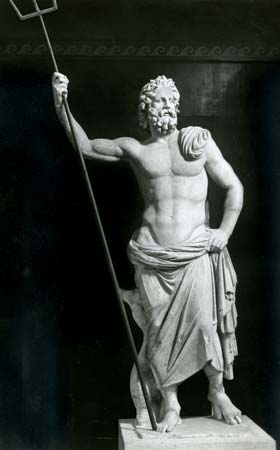 God of the sea and brother to Zeus. Poseidon plays a prominent part in numerous ancient myths and legends. He contended unsuccessfully with Athena for the control of Athens. When he and Apollo were cheated of their promised wages after having helped Laomedon, king of Troy, build the walls of that city. Poseidon’s revenge against Troy knew no bounds. He sent a terrible sea monster to ravage the land, and during the Trojan war he helped the Greeks.
God of the sea and brother to Zeus. Poseidon plays a prominent part in numerous ancient myths and legends. He contended unsuccessfully with Athena for the control of Athens. When he and Apollo were cheated of their promised wages after having helped Laomedon, king of Troy, build the walls of that city. Poseidon’s revenge against Troy knew no bounds. He sent a terrible sea monster to ravage the land, and during the Trojan war he helped the Greeks.
APOLLO
 God of prophecy and son of Zeus. He sometimes gave the gift of prophecy to mortals whom he loved. He was also gifted musician who delighted the gods with his performance on the lyre. He was a master archer and a fleet-footed athlete, credited with having been the first victor in the Olympian Games. He is the twin to Artemis and was the special protector of young men. As the god of agriculture and cattle and of light and truth. He taught humans the art of healing. Because of his beauty he was represented in ancient art more frequently than other deities.
God of prophecy and son of Zeus. He sometimes gave the gift of prophecy to mortals whom he loved. He was also gifted musician who delighted the gods with his performance on the lyre. He was a master archer and a fleet-footed athlete, credited with having been the first victor in the Olympian Games. He is the twin to Artemis and was the special protector of young men. As the god of agriculture and cattle and of light and truth. He taught humans the art of healing. Because of his beauty he was represented in ancient art more frequently than other deities.
DIONYSUS
 God of wine and vegetation, who showed mortals how to cultivate grapevines and make wine. A son of Zeus. He is usually characterized as the god of vegetation-specifically of the fruit of the trees-he is often represented drinking horn and vine branches. He eventually became the popular Greek god of wine and cheer.
God of wine and vegetation, who showed mortals how to cultivate grapevines and make wine. A son of Zeus. He is usually characterized as the god of vegetation-specifically of the fruit of the trees-he is often represented drinking horn and vine branches. He eventually became the popular Greek god of wine and cheer.
NIKE
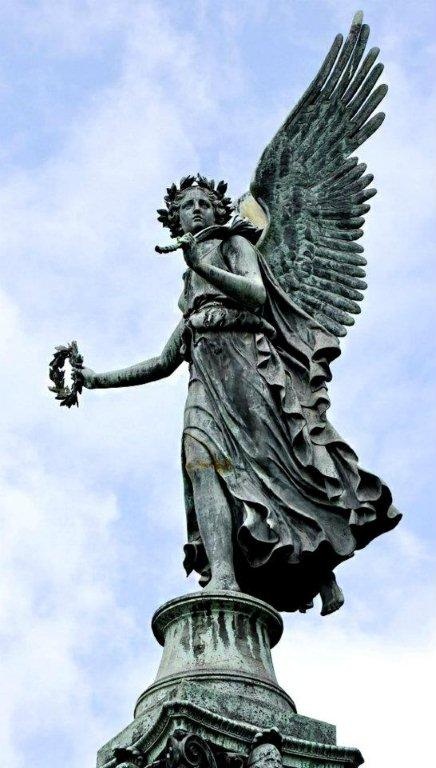 Goddess of victory. Nike fought with the god Zeus in his battle against the Titans. Nike is represented as winged and carrying a wreath or palm of victory.
Goddess of victory. Nike fought with the god Zeus in his battle against the Titans. Nike is represented as winged and carrying a wreath or palm of victory.
HERACLES
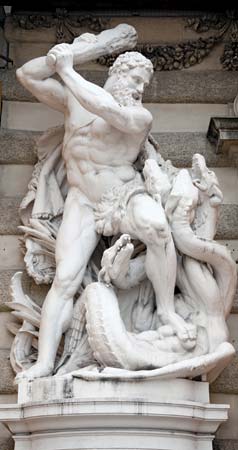 Hero noted for his strength and courage and for his many legendary exploits. Hercules if the Roman name for the Greek hero. He was the son of Zeus. As a young man Heracles killed a lion with his bare hands. As a trophy of his adventure, he wore the skin of the lion as a cloak and its head as a helmet. He became the servant of his cousin and devised the 12 difficult tasks, the labors of Heracles. Heracles was worshiped by the Greeks as both a god and as a mortal hero. He is usually represented as strong and muscular, clad in a lion skin and carrying a club. After death he was brought by the gods to Olympus and married to Hebe, goddess of youth.
Hero noted for his strength and courage and for his many legendary exploits. Hercules if the Roman name for the Greek hero. He was the son of Zeus. As a young man Heracles killed a lion with his bare hands. As a trophy of his adventure, he wore the skin of the lion as a cloak and its head as a helmet. He became the servant of his cousin and devised the 12 difficult tasks, the labors of Heracles. Heracles was worshiped by the Greeks as both a god and as a mortal hero. He is usually represented as strong and muscular, clad in a lion skin and carrying a club. After death he was brought by the gods to Olympus and married to Hebe, goddess of youth.
HELIOS
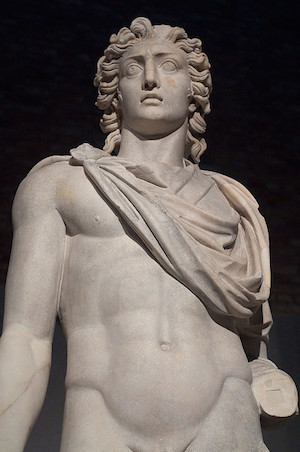 The ancient Greek sun god. Helios was believed to ride his golden chariot across the heavens daily, giving light to gods and mortals. At evening he sank into the western ocean from which he was carried in a golden cup back to his palace in the east. Helios alone could control the fierce horses that drew his fiery chariot.
The ancient Greek sun god. Helios was believed to ride his golden chariot across the heavens daily, giving light to gods and mortals. At evening he sank into the western ocean from which he was carried in a golden cup back to his palace in the east. Helios alone could control the fierce horses that drew his fiery chariot.
GORGON
 In Greek mythology, one of the monstrous daughters of the sea god PHORCYS and his wife, Ceto. The Gorgons were terrifying, dragonlike creatures, covered with golden scales and having snakes for hair. They had huge wings and round, ugly faces; their tongues were always hanging out, and they had large, tusklike teeth. They lived on the farthest side of the western ocean, shunned because their glance turned persons to stone. Two of the Gorgons, Stheno and Euryale, were immortal; Medusa alone could be killed.
In Greek mythology, one of the monstrous daughters of the sea god PHORCYS and his wife, Ceto. The Gorgons were terrifying, dragonlike creatures, covered with golden scales and having snakes for hair. They had huge wings and round, ugly faces; their tongues were always hanging out, and they had large, tusklike teeth. They lived on the farthest side of the western ocean, shunned because their glance turned persons to stone. Two of the Gorgons, Stheno and Euryale, were immortal; Medusa alone could be killed.
MEDUSA
 She was the most famous Gorgon. She began life as a beautiful young girl until she upset one of the most powerful Greek goddess, Athena, who exacted her revenge by turning Medusa’s lovely hair into a nest of poisonous snakes. The hero Perseus, a gallant but foolish young man, volunteered to kill Medusa and bring back her head. With the help of the deities Hermes and Athena, Perseus cut off Medusa’s head. From her blood sprang the winged horse Pegasus, her son by the god Poseidon.
She was the most famous Gorgon. She began life as a beautiful young girl until she upset one of the most powerful Greek goddess, Athena, who exacted her revenge by turning Medusa’s lovely hair into a nest of poisonous snakes. The hero Perseus, a gallant but foolish young man, volunteered to kill Medusa and bring back her head. With the help of the deities Hermes and Athena, Perseus cut off Medusa’s head. From her blood sprang the winged horse Pegasus, her son by the god Poseidon.
PEGASUS
 In Greek mythology, winged horse, son of Poseidon, god of the sea, and the Gorgon Medusa. Shortly after its birth, the magic steed struck the ground on Mount Helicon, and on the spot a spring began to flow. All longed in vain to catch and tame the creature. As Bellerophon spent a night in the temple of the goddess Athena and while he slept a golden bridle was given to him by Athena in his dream. When he awoke the bridle was beside him, with it he easily caught Pegasus and aided the hero in his adventures against the Amazons and the Chimaera. When Bellerophon attempted to fly to the top of Olympus to join the gods, the wise horse threw him. Pegasus found shelter in the Olympian stalls and was entrusted by Zeus with bringing him his lightning and thunderbolts.
In Greek mythology, winged horse, son of Poseidon, god of the sea, and the Gorgon Medusa. Shortly after its birth, the magic steed struck the ground on Mount Helicon, and on the spot a spring began to flow. All longed in vain to catch and tame the creature. As Bellerophon spent a night in the temple of the goddess Athena and while he slept a golden bridle was given to him by Athena in his dream. When he awoke the bridle was beside him, with it he easily caught Pegasus and aided the hero in his adventures against the Amazons and the Chimaera. When Bellerophon attempted to fly to the top of Olympus to join the gods, the wise horse threw him. Pegasus found shelter in the Olympian stalls and was entrusted by Zeus with bringing him his lightning and thunderbolts.
CHIMAERA
Common name for members of any of three families of deep-water cartilaginous fishes related to sharks. Reaching more than 6 ft .in length, they feed on smaller animals in temperate oceans. The color of their scaleless skin ranges from black to brownish gray, sometimes with markings, and the eyes are large. In several species, such as the ratfishes, the tail is long. Ratfishes also bear a poisonous spine directly in front of the dorsal fin. The eggs of chimaeras are laid in capsules of hornlike material. The Chimaera was a monster in the form of a lion with the additional heads of a dragon and a goat on its back, and that of a snake head at the end of its tail. The fire-breathing Chimaera was slain by Bellerophon with the help of Pegasus.
GRIFFIN
 Legendary creature, usually represented in literature and art as having the head, beak, and wings of an eagle, the body and legs of a lion, and occasionally a serpent’s tail. The griffin seems to have originated in the Middle East, as it is found in the paintings and sculptures of the ancient Babylonians, Assyrians, and Persians. The Romans used the griffin merely for decorative purposes in friezes and on table legs, altars and candelabra. The griffin motif appeared in early Christian times in the bestiaries, or beast allegories. The griffin is still a familiar device in heraldry and is thought to represent strength and vigilance.
Legendary creature, usually represented in literature and art as having the head, beak, and wings of an eagle, the body and legs of a lion, and occasionally a serpent’s tail. The griffin seems to have originated in the Middle East, as it is found in the paintings and sculptures of the ancient Babylonians, Assyrians, and Persians. The Romans used the griffin merely for decorative purposes in friezes and on table legs, altars and candelabra. The griffin motif appeared in early Christian times in the bestiaries, or beast allegories. The griffin is still a familiar device in heraldry and is thought to represent strength and vigilance.
TARAS
Most Greek cities had foundation mythologies, which tell of the circumstances under which a city was founded. The South Italian city of Taras, which was originally populated by people from the Greek city of Sparta, but was founded with the help of the Gods. Legend has it that a youth named Taras, who was a son of Poseidon, the Greek god of the oceans, was shipwrecked and then saved by a friendly dolphin, who took him to shore upon his back. In honor of his rescue, he founded a city at the place where they landed.
ROMAN DEITIES
MINERVA
 Goddess of handicrafts, patron of the arts and trades along with wisdom and war.
Goddess of handicrafts, patron of the arts and trades along with wisdom and war.
DIANA
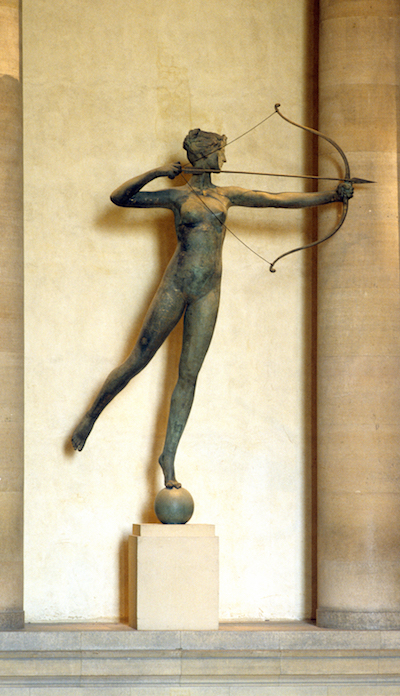 Goddess of the moon and the hunt. Diana was the guardian of springs and streams and the protector of wild animals. She was revered by women, and was believed to grant an easy childbirth to her favorites. She is typically shown as a young hunter, often carrying bow and arrows.
Goddess of the moon and the hunt. Diana was the guardian of springs and streams and the protector of wild animals. She was revered by women, and was believed to grant an easy childbirth to her favorites. She is typically shown as a young hunter, often carrying bow and arrows.
VENUS
 Originally a goddess of gardens and fields but later the goddess of love and beauty. In imperial times she was worshiped under several aspects, the mother of hero Aeneas, the founder of Roman people, the bringer of good fortune, the bringer of victory and the protector of feminine chastity. She also was the mother of Cupid, god of love.
Originally a goddess of gardens and fields but later the goddess of love and beauty. In imperial times she was worshiped under several aspects, the mother of hero Aeneas, the founder of Roman people, the bringer of good fortune, the bringer of victory and the protector of feminine chastity. She also was the mother of Cupid, god of love.
MARS
 God of war. One of the most important Roman deities, Mars was regarded as the father of the Roman people because he was the father of Romulus, the legendary founder of Rome. The month of March was named for Mars. To commemorate his victory over the assassins of Julius Caesar in 42 BC. Augustus.
God of war. One of the most important Roman deities, Mars was regarded as the father of the Roman people because he was the father of Romulus, the legendary founder of Rome. The month of March was named for Mars. To commemorate his victory over the assassins of Julius Caesar in 42 BC. Augustus.
MERCURY
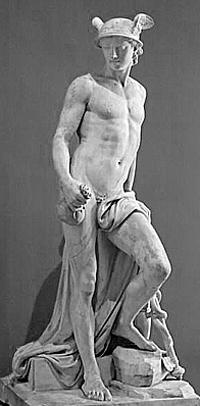 Messenger of the gods, the son of Jupiter. Mercury was also the god of merchants and of trading and shared many attributes of the Greek god Hermes.
Messenger of the gods, the son of Jupiter. Mercury was also the god of merchants and of trading and shared many attributes of the Greek god Hermes.
JUPITER
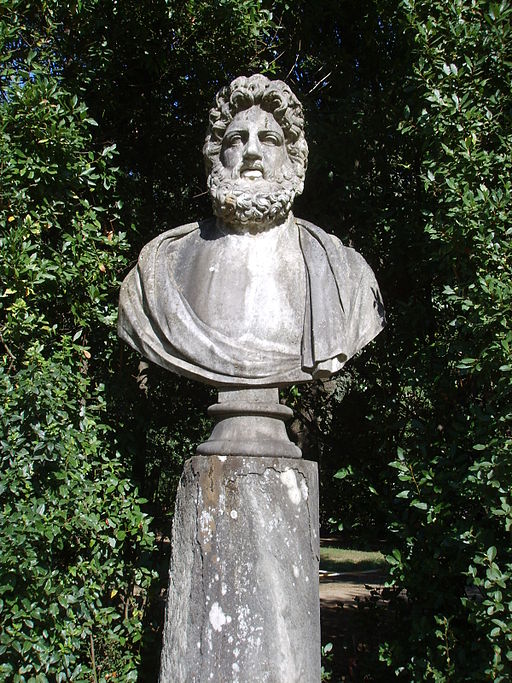 The ruler of the gods, originally the god of the sky and king of heaven. Jupiter was worshiped as god of rain, thunder, and lightning. He was the protector of Rome. He was the guardian of law, defender of truth, and protector of justice and virtue. The Romans assigned the attributes and myths of the Greek divinity Zeus.
The ruler of the gods, originally the god of the sky and king of heaven. Jupiter was worshiped as god of rain, thunder, and lightning. He was the protector of Rome. He was the guardian of law, defender of truth, and protector of justice and virtue. The Romans assigned the attributes and myths of the Greek divinity Zeus.
NEPTUNE
 God of the sea, son of the god Saturn, and brother of Jupiter. Originally a god of springs and streams.
God of the sea, son of the god Saturn, and brother of Jupiter. Originally a god of springs and streams.
APOLLO
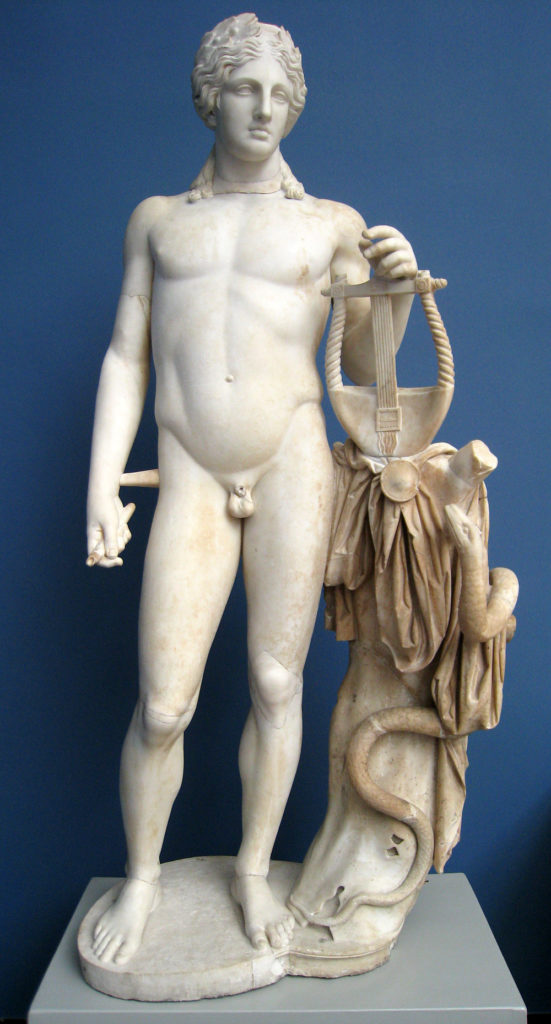 The Roman sun god and the god of music and arts. He usually has the title Conservator, or Palatinus (protector of the imperial residence on the Palatine) or Moneta (deity of the mint).
The Roman sun god and the god of music and arts. He usually has the title Conservator, or Palatinus (protector of the imperial residence on the Palatine) or Moneta (deity of the mint).
BACCHUS
 God of wine. Usually holds a wine cup and a staff surmounted by a pine cone or a bunch of grapes and accompanied by a panther.
God of wine. Usually holds a wine cup and a staff surmounted by a pine cone or a bunch of grapes and accompanied by a panther.
VICTORIA
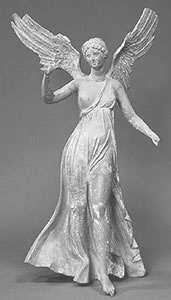 Victory, winged. Holds wreath and palm. May be bearing a shield or may be writing upon a shield or erecting a trophy. (The process of erecting a trophy was an ancient one and symbolized victory over the enemy in the field.)
Victory, winged. Holds wreath and palm. May be bearing a shield or may be writing upon a shield or erecting a trophy. (The process of erecting a trophy was an ancient one and symbolized victory over the enemy in the field.)
JANUS
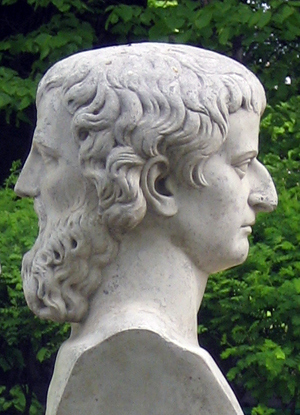 The god of doors and gateways, and also of beginnings, which the Romans believed ensured good endings. His principal temple in the Forum had doors facing east and west for the beginning and ending of the day, and between them stood his statue with two faces, gazing in opposite directions. In every home the morning prayer was addressed to him, and in every domestic undertaking his assistance was sought. He was publicly invoked on the first day of January, the month that was named for him because it began the new year. The doors of his temple in the Forum was always open during war and closed during peace.
The god of doors and gateways, and also of beginnings, which the Romans believed ensured good endings. His principal temple in the Forum had doors facing east and west for the beginning and ending of the day, and between them stood his statue with two faces, gazing in opposite directions. In every home the morning prayer was addressed to him, and in every domestic undertaking his assistance was sought. He was publicly invoked on the first day of January, the month that was named for him because it began the new year. The doors of his temple in the Forum was always open during war and closed during peace.
ROMA
 One goddess which was uniquely Roman was Roma, who personified the glory that was the Republic and later the Empire. Roma is idealized as a protective goddess wearing a winged helmet, indicating the might of the Romans, who were expanding their territories at this time and beginning to threaten the ancient and wealthy Greek kingdoms in Asia.
One goddess which was uniquely Roman was Roma, who personified the glory that was the Republic and later the Empire. Roma is idealized as a protective goddess wearing a winged helmet, indicating the might of the Romans, who were expanding their territories at this time and beginning to threaten the ancient and wealthy Greek kingdoms in Asia.
